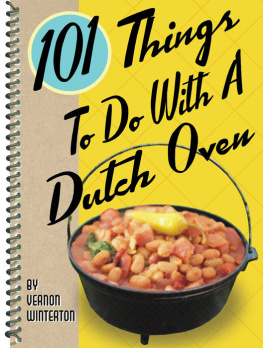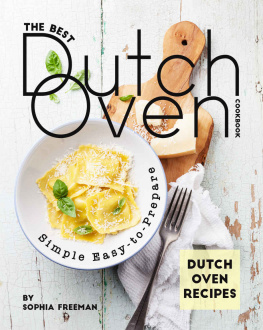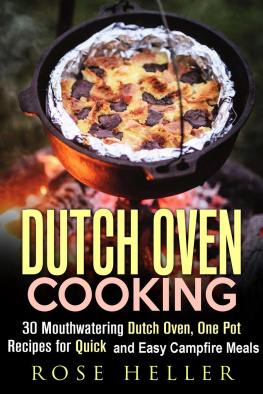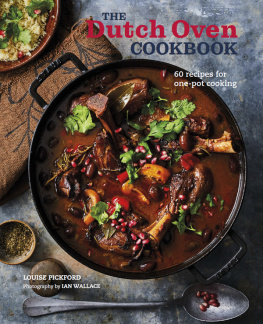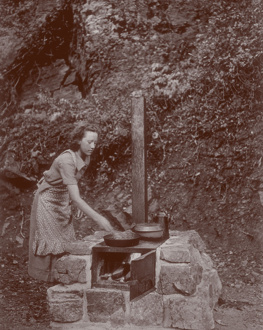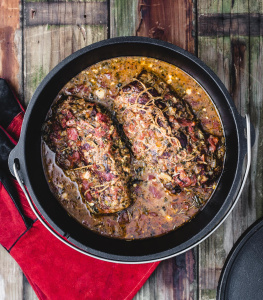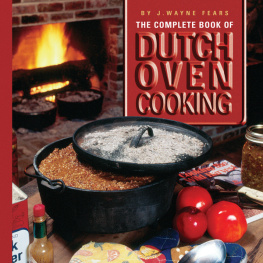All rights reserved. No part of this book may be reproduced by any means whatsoever without written permission from the publisher, except brief portions quoted for purpose of review.
I. Dutch oven cookery. I. Title: One hundred one things to do with a dutch oven. II. Title.
Helpful Hints
1. Use your Dutch oven year roundjust put it anywhere it will be protected from wind, such as a patio, garage, or even the oven. Wind carries the heat away, so it is important to be in a wind free area.
2. Charcoal briquettes are used in all recipes of this book. If cooking in your home oven, simply place Dutch oven inside without the coals and set your oven temperature as listed in the recipe.
3. When purchasing a Dutch oven, look for lumps in the casting. Lumps cause hot spots you want to avoid. Look at the thickness of all sides of a Dutch oven. If one side is thinner than the other, it will not cook evenly and your results will be poor. Also, make sure the lid sits flat and does not rock to ensure there is a good seal when cooking. However, if the lid moves side to side slightly, that is fine.
4. All Dutch ovens come with a wax on them to protect during shipping (unless it has been preseasoned). To season a new Dutch oven, scrub off all the wax and then coat with shortening. Place Dutch oven upside down in a barbecue or an oven (to allow shortening to drip off when heating), and heat to 400 degrees for 30 minutes. This begins to make the nonstick surface for which Dutch ovens are famous. Let the oven cool naturally, and when you can touch it with your hands, place the lid back on the Dutch oven and let it continue to cool. The more you use the oven, the more seasoned or nonstick it will become. Depending on the frequency of use, you may have to season several times a year. When the oven starts to smell rancid, do the whole seasoning process again.
5. When you clean a Dutch oven after it has been seasoned, don't use soap. The soap pulls the seasoning out and you will have to season it again. Use really hot water and a plastic scrubbing pad. Never use anything metal. Metal will scrape away the oven's nonstick surface.
6. Store a Dutch oven with something between the lid and the pot, such as a rolled up paper towel. This allows air to flow through it during storage and helps keep the oven from becoming rancid. If the oven gives off a funny pungent smell, you know it is rancid and needs to be seasoned again. If you use your oven year round, it will not become rancid. If your oven becomes rusty, you are not using it often enough. Scrub the rust off with an SOS pad, dry, and then season it again.
7. Heat control is important in a Dutch oven. Take the size of the oven, such as a 12-inch, then double that number to 24. This gives you the number of coals to start with to reach 350 degrees of heat. A 14-inch would be 28, a 16-inch would be 32, and so on. Place 10 coals under the Dutch oven and put the rest on top. Each additional coal placed on the oven adds approximately 20 degrees. For baking, put most of the heat on the lid. For frying, put most of the heat on the bottom. You will almost never put a coal in the center of the oven (bottom or lid) as it will make a hot spot and burn food, causing poor results.
8. Experiment with your Dutch oven and get creative with your recipes. You may even want to enter a Dutch oven cook off. Look at the International Dutch Oven Society Web page for a cook off near you.
9. When cooking with a Dutch oven, be mindful of the size of your coals so your heat doesn't drop. When coals are the size of a quarter, it's time to replace them with new ones.
10. Rotate Dutch oven every 10 minutes by moving lid counterclockwise and bottom clockwise. This will help to cook more evenly, especially with cakes and breads.
11. Place moisture managers between the lid and the Dutch oven or use clothespins to help hold the lid ajar. This allows the moisture to escape as needed when reducing sauces or liquids in a recipe.
12. The Camp Chef Ultimate Dutch oven is a special Dutch oven that is designed for convection cooking. It has two racks, one on the bottom for cooking the meat, and one near the top for cooking vegetables, and many other uses, such as for cooking pies. They come in either aluminum or cast iron.
Breakfast
Cinnamon Rolls
Dutch oven size: 14-inch
| 1/2 cup sugar |
| 3/4 cup warm water |
| 2 tablespoons active dry yeast |
| 1 cup milk |
| 1/2 cup potato flakes |
| 3/4 cup butter or margarine, softened and divided |
| 1 teaspoon salt |
| 2 eggs |
| 4 to 4-1/2 cups flour, divided |
| 3 teaspoons cinnamon |
| 1-1/2 cups brown sugar |
| 1-1/2 cups raisins (optional) |
| 3/4 cup chopped pecans (optional) |
| 1 container vanilla or cream cheese frosting |
In a large bowl, combine sugar, water, yeast, and milk and then let sit 5 minutes. Add potato flakes and mix well. Mix in 1/2 cup butter, salt, eggs, and 2 cups flour: beat well. Add remaining flour to form a soft, elastic dough. Cover and let rise until double in size. Punch down dough and roll out to 9 x 11 inches, and about 1/4 inch thick. Spread with remaining butter and sprinkle with cinnamon, sugar, and raisins and pecans, if desired. Roll, starting with the longer side, like a jelly roll. Cut 10 to 12 individual rolls using thread or string. Place in Dutch oven sprayed with nonstick spray. Cover and let rise until double in size. Bake at 350 degrees using 12 coals on bottom and 16 on top. Bake 25 to 30 minutes, or until done. Frost rolls while warm. Makes 10 12 cinnamon rolls.
Sticky Buns
Dutch oven size: 12-inch
| 1 cup hot milk |
| 1 tablespoon butter or margarine |
| 1/4 cup warm water |
| 1 tablespoon sugar |
| 1 tablespoon active dry yeast |
| 3-1/2 cups flour, divided |
| 1/4 teaspoon salt |
| 1 egg, beaten |
| 1/2 cup butter or margarine, melted |
| 1 cup brown sugar |
| 1 bag (10 ounces) pecan gems |
In a small bowl, combine hot milk and butter until butter melts.
In a large bowl, combine water, sugar, and yeast and set aside. In a separate bowl, combine half the flour, salt, egg, and milk butter mixture. Beat 5 minutes. Add yeast mixture. Add remaining flour and knead on a floured surface 10 minutes or until dough is elastic. Place in Dutch oven sprayed with nonstick spray. Cover with lid and place 3 coals on top to speed up the rising process. Let rise 30 minutes, or until double in size. Remove from Dutch oven and roll into a long log, about 2 to 3 inches in diameter, using your hands. Cut the log into 16 equal pieces. Form a ball with each piece and dip into remaining melted butter about halfway.

